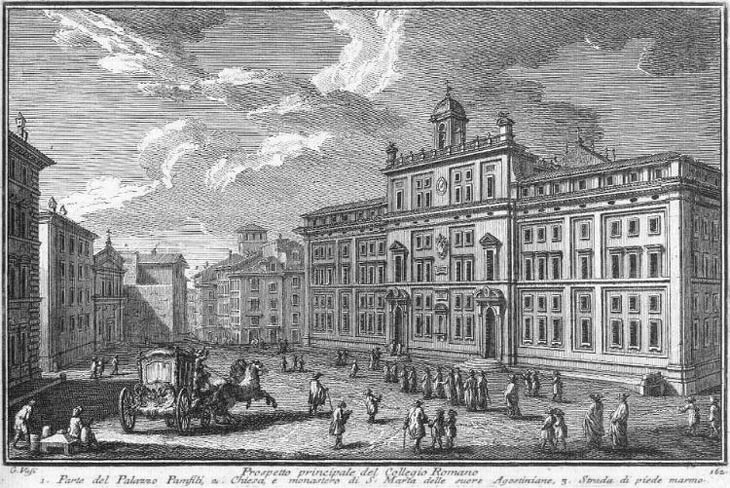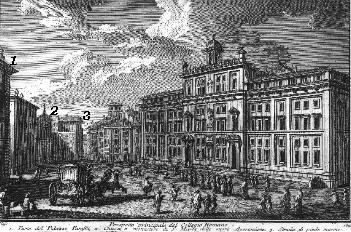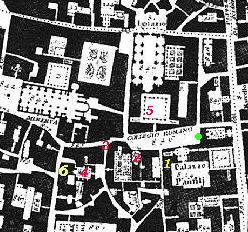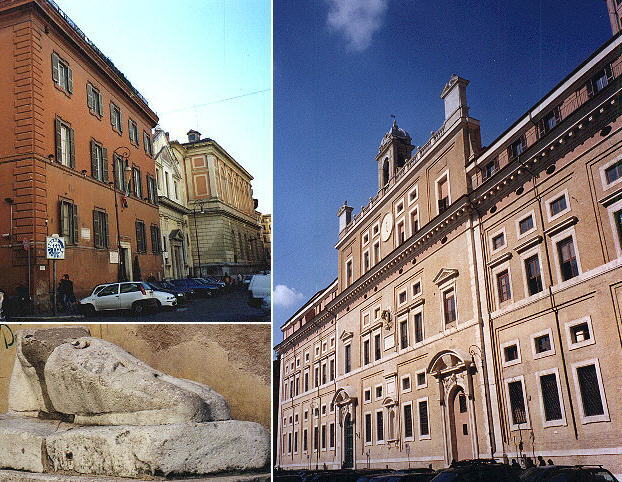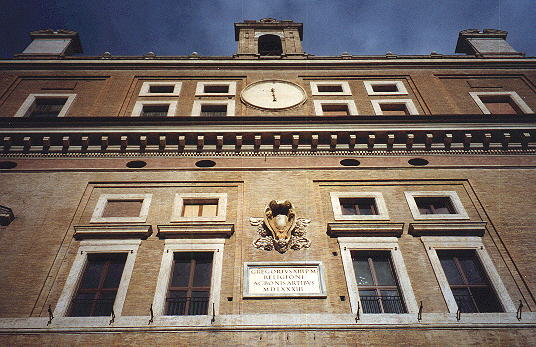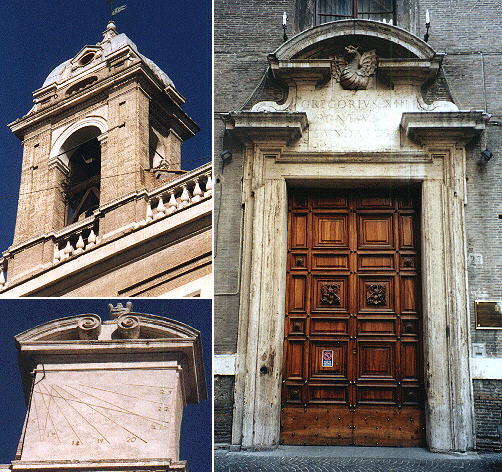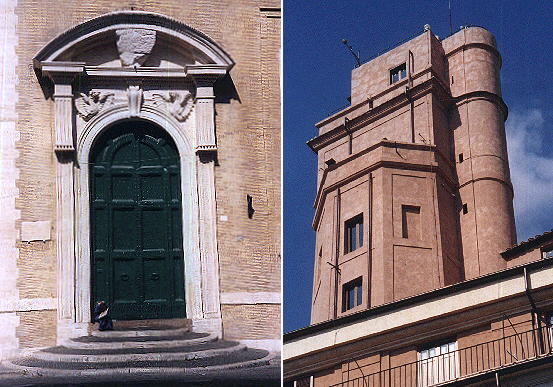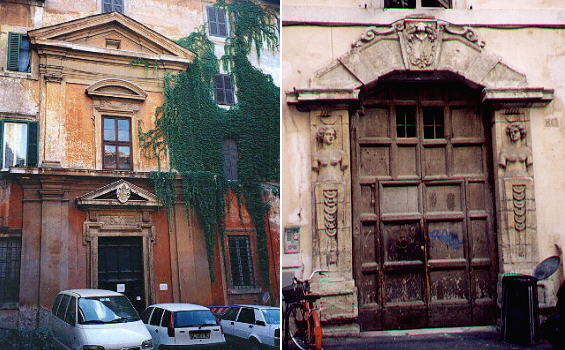

Prospetto Principale
del Collegio Romano (Book
9) (Map
B2) (Day 1) and (Day 4) (View C7) (Rione Pigna)
In this page:
The plate by Giuseppe Vasi
Today's view (including Piè di Marmo)
Collegio Romano
S. Stefano del Cacco and Palazzo Frangipane
The Plate (No. 162)
The Counter Reformation effort needed support from a theological/cultural
viewpoint. To this purpose Gregorius XIII erected this large college for
the Jesuits. Many popes studied here. On the left side the church and
monastery of S. Marta, at the end of the square the street leading to Piè
di Marmo (the marble foot). The view is taken from the green dot in the 1748 map below.
In the description below the plate Vasi made reference to: 1) Part of Palazzo Panfili;
2) S. Marta; 3) Street leading to Piè di Marmo. 1) is shown in another page. The map shows also
4) S. Stefano del Cacco; 5) Collegio Romano; 6) Palazzo Frangipane.
Today
The college is now a high school owned by the state (considered among
the best ones in Rome); the monastery is a police district headquarters.
In a narrow side street close to the monasteru the colossal foot of a statue (Piè di Marmo) still surprises the passers-by.
Collegio
Romano
The coat of arms of Gregorius XIII has lost its papal attributes,
but the dragon of the Boncompagni remains on the portals and on the sundials
(below the afternoon sundial).
Gregorius XIII is known for the reformation of the calendar which
established that the years at the end of the centuries which can be divided
by 4 are leap-years. So the year 20(00) was a leap-year, but the year 19(00)
was not a leap-year. He obviously encouraged astronomic studies and Collegio
Romano still retains the observatory built in more recent times to allow
a better view of the sky over Rome.
S.
Stefano del
Cacco and Palazzo Frangipane
The church is located on the site of the Temple of Isis and Serapis,
two Egyptian deities. The temple was the main building of a large complex
(Iseum Campense) embellished with obelisks and statues (Piè di Marmo
and Madama
Lucrezia come from this complex). The name del Cacco is most likely
due to a nearby Egyptian statue of Thot (a god with the head of a dog),
which ended up by being thought to represent a macaco, hence cacco.
A small and somewhat hidden square in the street leading to il Gesù
is embellished by the early XVIIth century portal of Palazzo Frangipane. The Frangipane family played an important
role in Rome from the XIIth to the XIVth century. They had turned the Colosseo into
a fortress, but in the XVIIth century their influence and wealth were greatly reduced. They had
their family chapel in S. Marcello al Corso.
Excerpts from Giuseppe Vasi 1761 Itinerary related to this page:
Collegio Romano
Alla chiesa di s. Ignazio è unito questo magnifico Collegio, eretto col disegno di
Bartolommeo Ammannato da Gregorio XIII. per pubblica utilità de' giovani studiosi.
Perciò vi si insegna da' PP. Gesuiti la lingua latina, l'ebraica, la greca, e tutte
le scienze principiando dall'umanità, rettorica, mattematica, filosofia, e teologia,
e però vi concorrono delli studenti, anche di altri collegj. Oltre una copiosa e scelta
libreria, evvi ancora un museo di cose antiche, e curiose assai celebre.
Chiesa e Monastero di S. Marta
Da s. Ignazio di Lojola fu eretto il monastero, che incontro al collegio si vede,
per collocarvi le povere donne peccatrici, che volevano far penitenza. Ma poi
trasportate queste altrove nel 1561 vi furono introdotte delle vergini anche nobili, e
furono poste sotto la regola di s. Agostino, e però fu rinnovata, ed ornata la chiesa
con marmi, stucchi dorati e pitture. La Trasfigurazione nell' altare a destra è pittura di
Alessandro Grimaldi, il s. Francesco Saverio nell'altra di Paolo Albertoni, e
il s. Gio. Batista, che siegue di Francesco Cozza, Le tre Marie al sepolcro e quelle di
fianco all'altare maggiore sono di Luigi Garzi, l'altro incontro di Fabio Cristofari, e
la s. Maria Maddalena, e s. Marta sono di Guglielmo Cortesi. La ss. Vergine nell'altare,
che siegue è del Geminiani, l’altra col Bambino e s. Agostino è di Giacomo del Po,
il s. Angelo Custode nell'ultimo è di Francesco Rosa, e le pitture nella volta sono del
Baciccio.
...si vede nel cantone del secondo vicolo un
gran piede di marmo, che dà il nome alla strada, e alla contrada ancora,
ed entrando in quel medesimo vicolo si vede la
Chiesa di s. Stefano del Cacco
Fu questa eretta sull'antico tempio d' Iside e Serapide, abbruciato da Claudio Imperatore in occasione, che
Paolina nobile, e pudica matrona romana, fu ivi offesa da un tale chiamato Mondo, ingannata però
da' sacerdoti di quel tempio, i quali le diedero a credere esser amata da Anubi loro Dio: per lo qual
misfatto furono tutti fatti morire: ma il tempio fu poi rifatto da Aless. Severo, ed ornato di figure e simboli
usati dagli Egizi, de' quali furono i leoni di pietra egizia, che stanno nel fonte dell'acqua felice, e le
sfingi a piedi del Campidoglio, con altre quivi trovate. Fu conceduta questa chiesa ai Monaci
Silvestrini l'anno 1563. i quali l'hanno riattata, conservandola però nell'antica forma. Il Cristo morto è
di Pierin del Vaga, e le pitture a fresco nella tribuna sono del Consolano, ed altre del Baglioni.
|
Next plate in Book 9: Collegio
Romano e S. Ignazio
Next step in Day 1 itinerary: Palazzo Panfilio
Next step in Day 4 itinerary: Palazzo Marescotti
Next step in tour of Rione Pigna: S. Maria in Via Lata

Go
to  or to Book
9 or to my Home
Page on Baroque Rome or to my Home Page on Rome
in the footsteps of an XVIIIth century traveller.
or to Book
9 or to my Home
Page on Baroque Rome or to my Home Page on Rome
in the footsteps of an XVIIIth century traveller.
|


